Position your UV lights within 2-4 feet of the air stream for maximum effectiveness, ensuring 6-12 inches of clearance from walls and corners. You'll want to place the purifier between floor level and waist height to optimize air circulation. Keep the unit away from direct sunlight and maintain regular cleaning of UV lamps to prevent dust buildup. Understanding the nuances of proper positioning and maintenance will reveal your air purifier's full sanitizing potential.
Understanding Light Spectrum Requirements
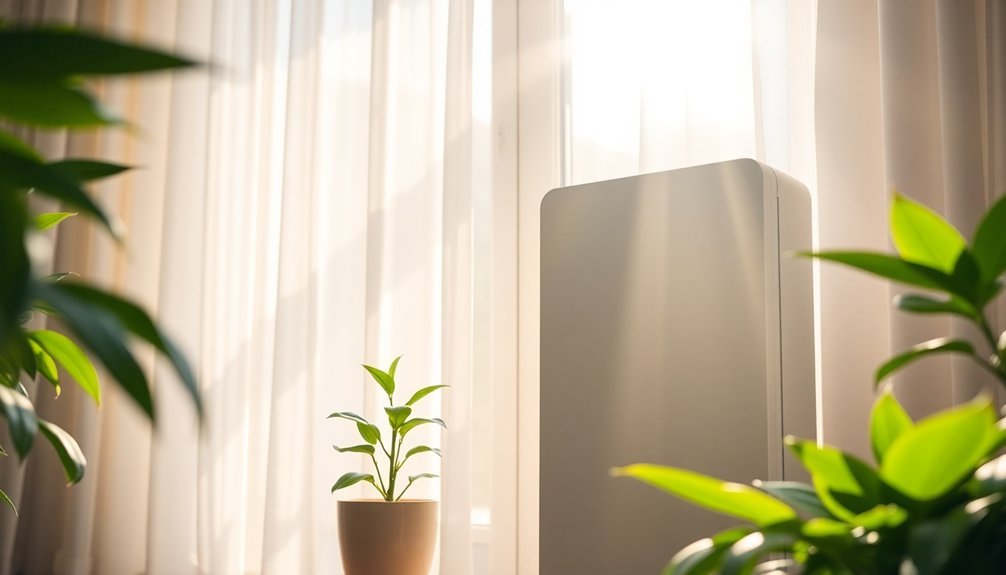
When designing an effective air purification system, understanding the UV light spectrum is essential for peak performance. You'll need to focus on UV-C light, particularly wavelengths around 254nm, as this range is most effective at deactivating airborne pathogens by disrupting their DNA and RNA structures.
While air purifiers work with different UV bands, UV-C light delivers the strongest disinfection capabilities compared to UVA and UVB. The light spectrum you choose directly impacts how well your system eliminates harmful microorganisms, including mold spores.
You should consider that UV-C light requires direct exposure to pathogens, so proper positioning is vital for maximum effectiveness. Remember that your UV lamps will need periodic replacement, typically every 9,000-12,000 hours, to maintain peak sanitization levels in your purification system.
Optimal Distance and Height Adjustments
When positioning your air purifier's lights, you'll need to maintain 6-12 inches of clearance from walls and corners to guarantee proper air circulation and visibility of indicator lights.
Your purifier works best when placed at floor level or up to 4 feet high, allowing you to easily monitor its operation while maintaining peak air filtration performance.
Avoid mounting the unit too high or in confined spaces, as this can compromise both the effectiveness of the lighting system and the purifier's ability to clean the air efficiently.
Ceiling to Floor Spacing
The ideal spacing between ceiling and floor plays a crucial role in maximizing your air purifier's performance. You'll need to take into account both vertical clearance and positioning to guarantee efficient air flow throughout your space. For the best clean air delivery rate, maintain at least 6 inches of clearance from walls and furniture, while positioning your unit 3-4 feet above the floor.
- For ceiling-mounted units, install at 8-10 feet height for maximum coverage area.
- Keep purifiers away from low-ceiling areas to guarantee unrestricted air circulation.
- Position units where ceiling fixtures won't interfere with airflow patterns.
Your air purifier needs adequate vertical space to draw in air from all directions effectively. By following these spacing guidelines, you'll create an environment where your purifier can operate at peak efficiency, delivering cleaner air throughout the room.
Wall Clearance Requirements
Building on proper ceiling clearance, proper wall spacing emerges as another key factor in air purifier placement. When positioning your air purifier near walls, keep in mind that you'll need at least six inches of clearance for ideal performance.
It's best to place the unit with a full foot of space on all sides to maximize air intake from multiple directions. Avoid positioning your air purifier directly against walls or in corners, as this greatly reduces its effectiveness.
Instead, maintain an unobstructed space around the unit at a height between floor level and waist height. Remember that furniture placement matters too – don't surround your air purifier with items that could block airflow.
Room Corner Positioning
Despite the temptation to tuck air purifiers into corners, this common placement mistake can severely limit their effectiveness. To achieve effective air filtration, you'll need to maintain proper clearance on all sides of your unit.
- Keep your air purifier at least one foot away from corners and walls to guarantee optimal airflow and maximize its ability to clean the air.
- Position the unit slightly elevated off the ground to enhance circulation throughout the room.
- Avoid placing the device behind furniture or in cramped spaces that restrict air intake.
Calculating Light Coverage Areas
You'll need to start by measuring your UV light's effective range, typically reaching 8-10 feet in ideal conditions for most air purifier models.
Your room's size directly affects the coverage requirements, with every 100 square feet demanding 20-30 watts of UV light power for thorough air treatment.
Consider your space's unique layout, as furniture placement and room architecture can impact the UV light's reach, potentially requiring strategic repositioning or additional units to guarantee complete coverage.
Measuring UV Light Range
When installing a UV air purifier, accurate measurement of the light's coverage area is essential for peak performance. You'll need to position your UV light within 2-4 feet of the air stream to maintain ideal effectiveness, as intensity diminishes considerably with distance.
To guarantee proper coverage in your space:
- Use a radiometer to test UV intensity levels, confirming they meet the required microwatts per square centimeter (µW/cm²).
- Verify the UV wavelength stays at 254nm UVC for maximum pathogen inactivation.
- Maintain direct line-of-sight between the UV source and air stream for efficient disinfection.
Remember to calculate the coverage area based on your lamp's output and the space's air volume.
Regular testing helps confirm your UV light system continues performing at peak efficiency, protecting your indoor air quality effectively.
Room Size Impact Factors
Since room dimensions directly affect air purifier performance, calculating the appropriate light coverage area requires careful consideration of your space's square footage.
To improve indoor air quality effectively, you'll need an air purifier with a Clean Air Delivery Rate (CADR) that's at least two-thirds of your room's area.
When you're planning your lighting setup, remember to leave adequate space around your air purifier – at least six inches from walls and furniture.
If you've got a larger room, you'll want a more powerful unit that can handle the increased area. For smaller spaces, consider using multiple units strategically placed throughout the room. This approach works especially well when you can't achieve uniform lighting due to furniture placement or room layout constraints.
Seasonal Light Positioning Strategies
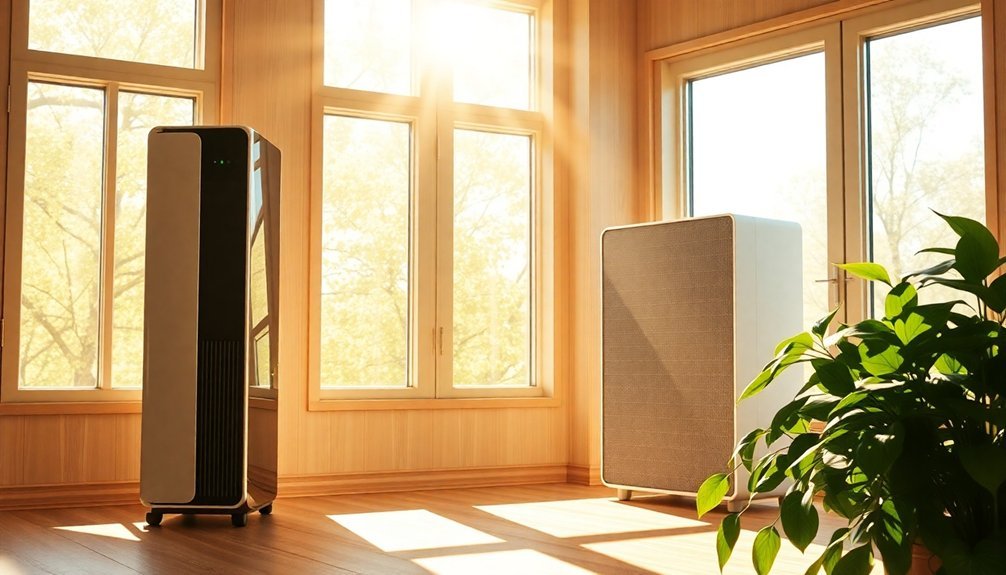
The strategic placement of your air purifier throughout the year can greatly impact its performance and your home's air quality.
You'll need to adjust your light source and purifier positioning as seasons shift to maximize effectiveness.
- Keep your air purifier near windows during winter to combat cold drafts while benefiting from natural light exposure.
- Move your purifier away from direct sunlight in summer months to prevent overheating.
- Position your unit strategically during changing seasons like spring and fall to address specific air quality challenges.
During warmer months, you'll want to protect your purifier from excess heat while maintaining ideal airflow.
Protecting your air purifier from heat exposure ensures optimal performance while proper airflow circulation keeps your space fresh and clean.
Place your device in damper areas like basements when humidity rises, and consider entryway placement during high pollen seasons.
Near windows and doors, your purifier can effectively capture incoming pollutants while maintaining proper ventilation.
Multiple Light Source Coordination
Beyond seasonal lighting considerations, coordinating multiple light sources around your air purifier requires careful planning and thoughtful placement.
You'll need to position each light at least five feet away from your purifier to maintain ideal clean air circulation and prevent any interference with its operation.
Set up ambient lighting to create a well-lit space that makes maintenance tasks easier, while strategically placing task lights to help you spot and remove potential airflow obstacles.
You can also install dimmable lights to adjust brightness levels during nighttime use without compromising your purifier's effectiveness.
When selecting your light fixtures, opt for energy-efficient options that produce minimal heat, as excessive warmth can impact your purifier's performance.
This balanced approach guarantees your space remains properly illuminated while maintaining peak air purification efficiency.
Managing Light Intensity Levels
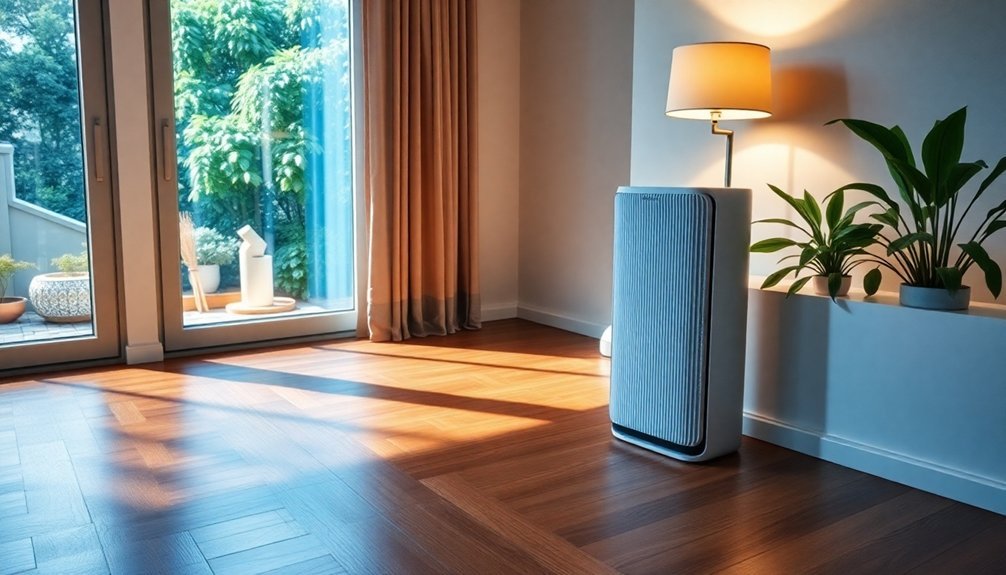
Maintaining proper light intensity in UV air purifiers plays a crucial role in maximizing their pathogen-fighting capabilities. You'll need to focus on ideal placement and guarantee unobstructed airflow to achieve maximum effectiveness in your air purification system.
Key factors for managing light intensity include:
- Regular cleaning of UV lamps to prevent dust buildup that can reduce effectiveness
- Timely replacement of bulbs before they reach their maximum lifespan (9,000-12,000 hours for standalone units)
- Strategic positioning that allows direct exposure to the airstream
You'll want to position your UV air purifier where it can maintain consistent light intensity throughout its operation.
Remember to utilize safety interlocks to protect the system while preserving the necessary intensity levels for effective pathogen elimination. Proper management of these elements guarantees your air purifier operates at peak performance.
Growth Stage Light Adaptations
Successfully growing plants with air purification systems requires strategic light adjustments throughout different growth stages.
During the seedling stage, you'll want to place your lights just 2-4 inches above your plants for ideal growth.
As you move into the vegetative phase, keep the lights between 12-24 inches away to guarantee even coverage without risking leaf damage.
The best place for your lights during flowering is 12-18 inches above the canopy, which promotes robust bud development.
Using full-spectrum LED grow lights is a game-changer for your air-purifying plants. They'll boost photosynthesis efficiency and support faster growth across all stages.
Remember to monitor your plants' response to light positioning and make adjustments as needed. Your plants will tell you if they need more distance or intensity through their growth patterns.
Light Schedule Programming
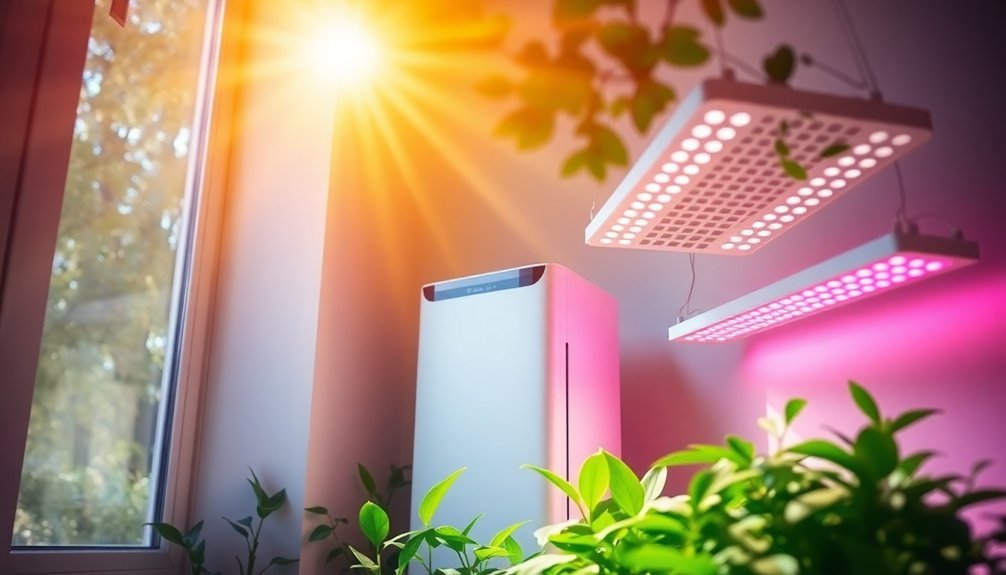
While proper light positioning sets the foundation for plant health, programming your air purifier's light schedule takes your indoor air quality to the next level.
Strategic placement and timing of your air purifier's lighting system creates the perfect environment for both thriving plants and pristine air quality.
By synchronizing your device's operation with peak usage times, you'll maximize its effectiveness when you need it most.
- Set your light schedule programming to align with your daily routine, especially during morning and evening hours when air quality typically fluctuates.
- Utilize smart home technology to coordinate your air purifier with other devices, creating an efficient ecosystem for cleaner air.
- Adjust your schedule seasonally to account for changing allergen patterns and pollution levels.
Don't forget to take advantage of built-in timers for automated operation.
This hands-free approach guarantees consistent air purification throughout your space while optimizing energy consumption and maintaining ideal air quality levels year-round.
Creating Multi-Layer Light Systems
To maximize your air purifier's effectiveness, implementing a multi-layer light system creates an environment where pollutants have nowhere to hide. You'll improve air quality by combining adjustable lighting solutions that guarantee peak visibility throughout your space.
| Layer Type | Position | Purpose |
|---|---|---|
| Task Lights | Above Purifier | Monitor Maintenance |
| Wall Sconces | Side Walls | Eliminate Shadows |
| Floor Lamps | Room Corners | Ambient Coverage |
| Dimmable LEDs | Ceiling | Time-based Control |
| Accent Lights | Strategic Points | Zone Highlighting |
Consider incorporating both cool and warm light temperatures to enhance your space's functionality. Position task lighting directly above your purifier for maintenance checks, while using indirect lighting to maintain proper airflow. You'll create a well-lit environment that supports your purifier's performance while maintaining comfort for various activities throughout the day.
Frequently Asked Questions
Where Should I Put My Air Purifier for Best Results?
Place your air purifier at least 6 inches from walls, near pollution sources, and in rooms where you spend most time. Don't put it in corners, and make certain it has a foot of space around it.
Do Air Purifiers Work When the Windows Are Open?
Yes, your air purifier will work with open windows, but it's less effective. You'll get better results by limiting open windows and placing the purifier near entry points to catch incoming pollutants.
Should I Put an Air Purifier Next to Bed?
Yes, you'll benefit from placing an air purifier next to your bed, but keep it at least six inches away. It'll filter allergens and improve your sleep quality, especially if you choose one with sleep mode.
Should an Air Purifier Go on the Floor or Desk?
You'll get better air purification by placing your unit on the floor, where it can effectively pull in air from all directions. While desks are convenient, they limit airflow and reduce overall performance.
In Summary
Position your lights strategically to maximize your air purifying plants' growth potential. You'll want to maintain proper distances, coordinate multiple sources, and adjust seasonally for the best results. Remember to adapt your lighting setup as your plants mature and don't forget to program consistent schedules. With careful attention to positioning and intensity levels, you're setting up your green air purifiers for long-term success.

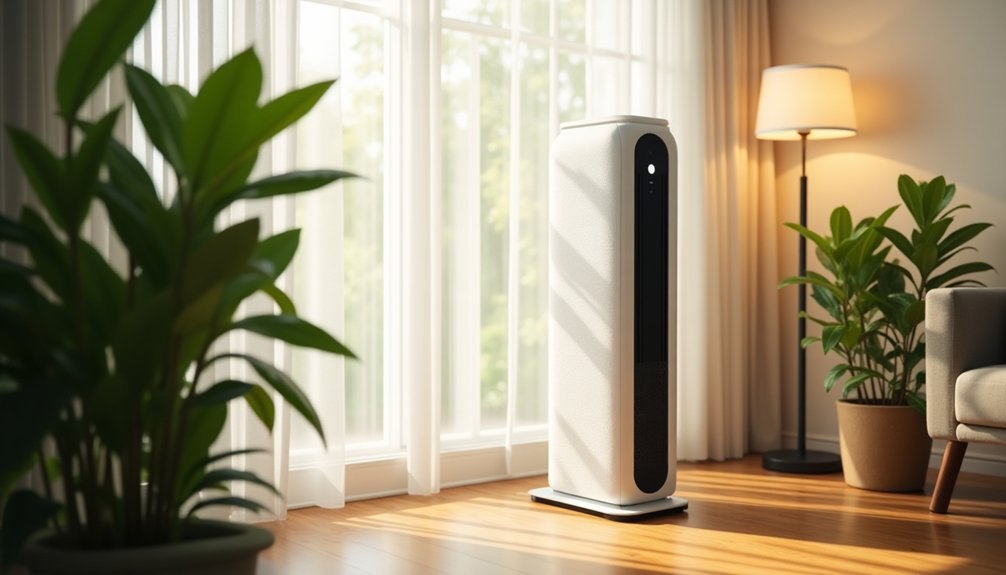



Leave a Reply